CM605: Has Mankind altered Earth's Temperature?
A decisive test for man-made global temperature change:
The Reality Check for Greenhouse
David Noel
<davidn@aoi.com.au>
Ben Franklin Centre for Theoretical Research
PO Box 27, Subiaco, WA 6008, Australia.
Temperatures of the Earth
One of the great controversies of the age is whether or not Man's activities have altered the temperature of our planet -- "Global Warming".
More recently, this topic has tended to come with the tag "Climate Change". Behind both tags is the lurking question in the room, "If there have been changes in the Earth's temperatures or climate, are these changes due, wholly or in part, to Man's activities?"
Here we are concerned with longer-term changes, changes over decades, centuries, or even millennia. Changes in temperature at a particular point of the Earth's surface occur for a variety of reasons. The one we notice most is the daily cycle caused as the Earth rotates on its axis.
Then we notice the yearly change with seasons, as the Earth orbits round the Sun, and in so doing presents a slightly different face (because the Earth's axis is tilted with respect to the plane along which radiation comes from the Sun).
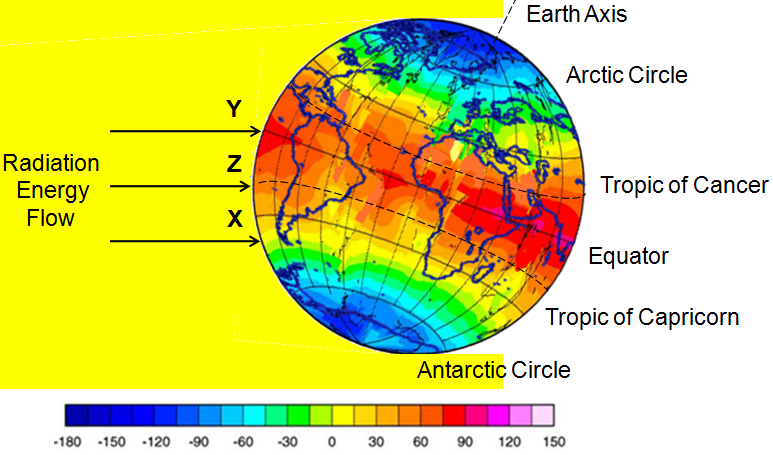
Figure CM605-F1. Most of the Earth's energy comes from the Sun. From [2].
Variations in radiation received by the Earth
The daily and seasonal changes in solar energy received are familiar to all. Neither is at exactly the same level all the time. In particular, it varies because the Earth's orbit round the Sun is an ellipse, rather than a perfect circle.
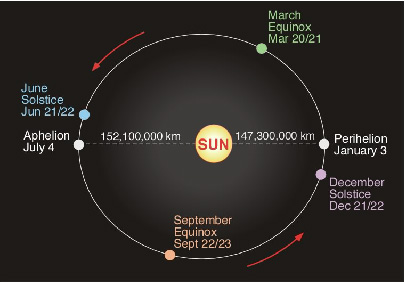
Figure CM605-F2. The Earth moves in an ellipse round the Sun. From [5].
The impact of this elliptical orbit is that the daily dose of energy we receive from the Sun varies by as much as 7%. On January 3, the Earth is at its closest to the Sun (Perihelion), while on July 4 it is farthest away (Perihelion).
There is more detail on this in Temperatures of the Earth -- a Globe in Space [4] and in XT808 - Global Temperatures [5].
The Earth is also subject to longer-term variations in energy received, for two main reasons. First, the energy emitted by the Sun may vary, both in shorter cycles (such as the 11-year sunspot cycle), and because of slower changes as it evolves.
Second, the Sun is itself in motion with respect to the rest of the Milky Way galaxy, and changes may occur in its own and in Earth's orbits -- the elliptical orbit is not fixed in shape, and the Earth's tilt also changes over time.
Are human activities altering the Earth's temperature?
There is currently a common and widespread belief that human activities have caused a rise in the Earth's average temperature. This belief is often maintained with almost religious zeal, in the face of countermanding evidence and logical reasoning.
The basics of this belief are (1) that carbon-dioxide levels in the atmosphere have increased markedly since the Industrial Revolution (from about 1760), due to burning of fossil fuels and clearing of forests; and (2) that the presence of carbon dioxide, and certain other gases (such as methane), in the atmosphere (dubbed "greenhouse gases") has increased the Earth's average temperature.
The fact that carbon dioxide levels have increased, as a result of human activities over the last two and a half centuries, is solidly evidenced and not in dispute at this time. Whether carbon dioxide levels have any effect on atmospheric temperatures is entirely another matter, and the crux of the present article.
It is my contention that they do not. In EP301: Will Greenzilla Destroy the Earth? The Facts Behind Global Warming [6] this matter has been analyzed and, in my view, the belief that CO2 affects global temperatures has been completely discredited. So, in the face of an often bitter dispute, is there any certain way of determining which view is the more correct? There is.
Temperatures of the Moon
There is no even vaguely plausible reason for assuming that changes in the Earth's atmosphere can affect the temperature of our Moon. So, by comparing the longer-term behaviour of temperatures on the Earth and on the Moon, it should be possible to reach an unequivocal conclusion as to whether observed temperature patterns are explicable by variations in radiation from outside affecting Earth and Moon equally, or whether Earth shows anomalous changes which must be ascribed to events on Earth alone.
It is a simple matter to measure the temperature at a given time and position on the Moon, this is done by pointing a radiometer (a type of thermometer) at the particular spot. This was first done in 1868 by Lord Rosse [3]. In an article published in 1958 [3], William Sinton describes the techniques and equipment developed since then, used also to measure the temperatures of the planets Mercury, Venus, Mars, Jupiter, and Saturn.
Sinton's article also includes a graph of changes in the temperature of a point on the Moon during a 1939 lunar eclipse.
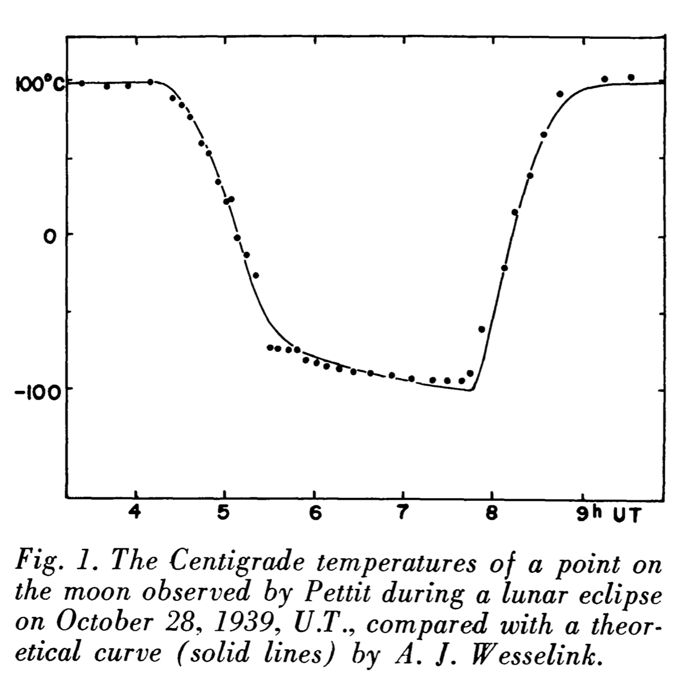
Figure CM605-F3. Moon temperatures during an eclipse. From [3].
The graph shows how a section of the Moon's surface at a temperature of 100 deg C under full sunlight dropped sharply over a period of less than 2 hours to almost minus 100 deg C when the Sun's light was cut off by the eclipse. When the Earth's shadow had passed from the point, the temperature rose rapidly back to its original level over the next hour.
Temperatures of the Earth
We also have a big range of data about temperatures on the Earth. Some of the longer runs, up to several thousand years in the past, have been derived indirectly from such things as tree growth rings (with a given tree species, the annual growth ring is dependent on the temperature).
Figure F4 shows one of these data sets, from around 900 AD up to the present. It can be seen that about 1000 years ago, temperatures reached a peak for this site at about equal to peak temperatures today. Between these peaks, temperatures were generally lower, though the variation between high and low points was only a little over 1 deg C.
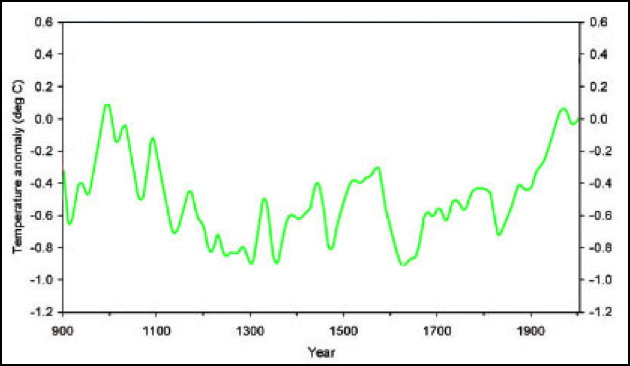
Figure CM605-F4. Northern-hemisphere temperature data based on tree rings. From [6].
In more recent years, we have directly-recorded temperature data sets, measured both at the surface and from satellite sensors. Figure F4 shows such a data set for the period 1995 to 2009, and also shows average CO2 level in the atmosphere for the same years. While the variation range is again only a little over 1 deg C, there are clear peaks in 1998 and 2007, and clear dips in 1999/2000 and 2008/2009. No interpretation of this graph would suggest any correlation between temperature and CO2 level.
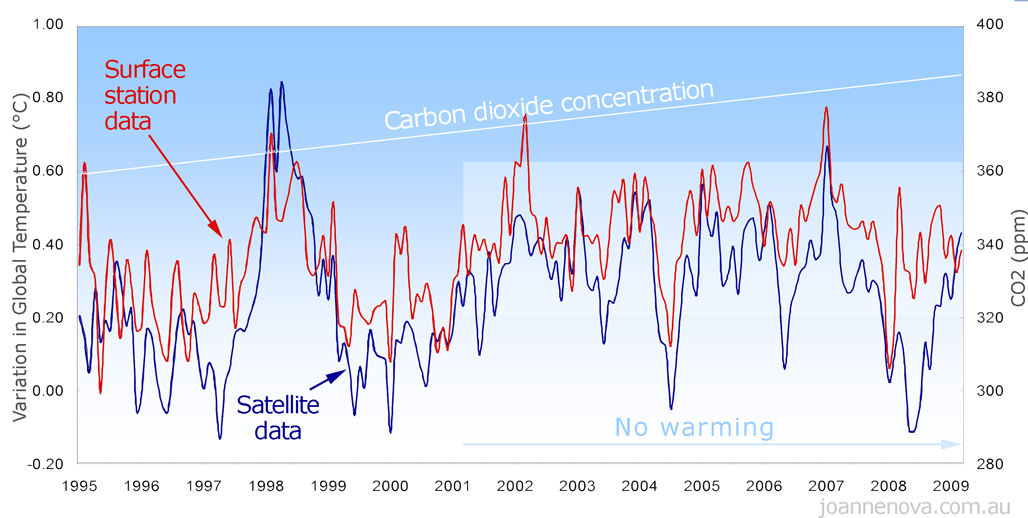
Figure CM605-F5. Earth's temperatures and CO2 levels, 1995-2009 . From [7].
If we had a good temperature data set for a point on the Moon under standard conditions (say at lunar midnight on the lunar equator), we should be able to easily determine whether Moon temperatures and Earth temperatures moved in concert or not. If so, this would mean that the temperature changes of both bodies were essentially dependent on external factors, such as variation in Solar output or in received orbital radiation.
We would expect Moon temperatures to be more stable than Earth ones, as Earth temperatures may be affected by large-scale weather shifts due to such things as changes in ocean currents. The Moon will be unaffected by climate factors.
Temperatures and human activities -- the final test
If the Earth shows temperature patterns which differ from those of the Moon, then it would be reasonable to assume that the difference might well be due to human activities, of whatever nature.
As noted above, recording of Moon temperatures is a simple matter, done easily from Earth. Done routinely in future years, this method would demonstrate clearly whether human activities are responsible for observed climate changes.
As to the past, there may already be data sets for the Moon's temperature over earlier years, which would give an immediate answer to the question. So far I have not been able to source any such sets (other than for a short 3-year period after the Moon landings), but would be grateful to be informed of the existence of such data.
* * * * * * * * * * * * * * * * * * * * * * * *

References and Links
[1]. Why is climate change happening?
https://climate.nasa.gov/causes .
[2]. Earth Changes. https://planet-earth-2017.com/heat-not-from-the-sun/ .
[3]. William M Sinton. Taking the temperatures of the Moon and planets. http://adsbit.harvard.edu/cgi-bin/nph-iarticle_query?1958ASPL....7..361S&defaultprint=YES&filetype=.pdf .
[4]. David Noel. Temperatures of the Earth -- a Globe in Space (a re-analysis with some surprising results). http://www.aoi.com.au/bcw/EarthTemp/index.htm .
[5]. David Noel. XT808 - Global Temperatures. http://www.aoi.com.au/Extracts/XT808.htm .
[6]. David Noel. EP301: Will Greenzilla Destroy the Earth? The Facts Behind Global Warming. http://aoi.com.au/bcw/Greenzilla/index.htm .
[7]. What about the temperature trend?. http://climatescience.blogspot.com/2017/01/what-about-temperature-trend.html .
Go to the Cameos Home Page
Go to the AOI Master Page
Assembly started 2018 Aug 28. First version 1.0 on Web 2018 Sep 23.







